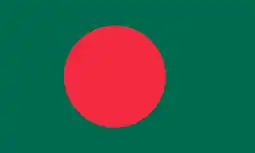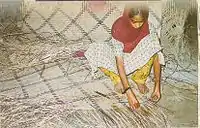Shital Pati
Sitalpati (Bengali:শীতল পাটি), also called sital pati and sittal pati, is a kind of mat which feels cold by nature. It is made from murta plants (Schumannianthus dichotomus). It is usually used in Bangladesh (and to a lesser extent, India's West Bengal). Mats with decorative designs are called nakshi pati.[1]
| Traditional Art of Sheetal Pati Weaving | |
|---|---|
 Sheetal Pati Self Weaving | |
| Country | Bangladesh |
| Domains | Traditional craftsmanship |
| Region | Asia and the Pacific |
| Inscription history | |
| Inscription | 2017 (12th session) |
 | |
| Part of a series on the |
| Culture of Bangladesh |
|---|
 |
| Traditions |
| Religion |
| Sport |
Sitalpati are made from cane or from murta plants, known in different places as mostak, patipata, patibet and paitara. The murta plant grows around water bodies in Sylhet, Sunamganj, Barisal, Tangail, Comilla, Noakhali, Feni and Chittagong. Nakshi pati made of murta plants is available only in Sylhet and Noakhali districts of Bangladesh. In India, Sitalpati is made in the northern Cooch Behar district of the state of West Bengal. Among the areas of Cooch Behar where Sitalpatis are woven, Sagareswar, Ghugumari and Pashnadanga are important centres. [2]

Recognition
UNESCO has recognised the Traditional Art of Shital Pati weaving of Sylhet and included it in the Representative List of the Intangible Cultural Heritage of Humanity.[3]
See also
- Nakshi kantha, decorative quilts made from cloth
References
- Banu, Zinat Mahrukh (2012). "Nakshi Pati". In Islam, Sirajul; Jamal, Ahmed A. (eds.). Banglapedia: National Encyclopedia of Bangladesh (Second ed.). Asiatic Society of Bangladesh.
- "Sitalpati Mat Weaving of West Bengal – Asia InCH – Encyclopedia of Intangible Cultural Heritage".
- ""Cultural Heritage: Shital Pati on Unesco list"". The Daily Star. 7 December 2017. Retrieved December 7, 2017.
External links
| Part of a series on the |
| Culture of Bengal |
|---|
 |
| History |
| Cuisine |